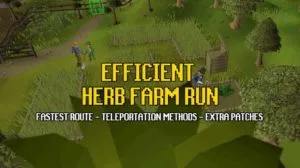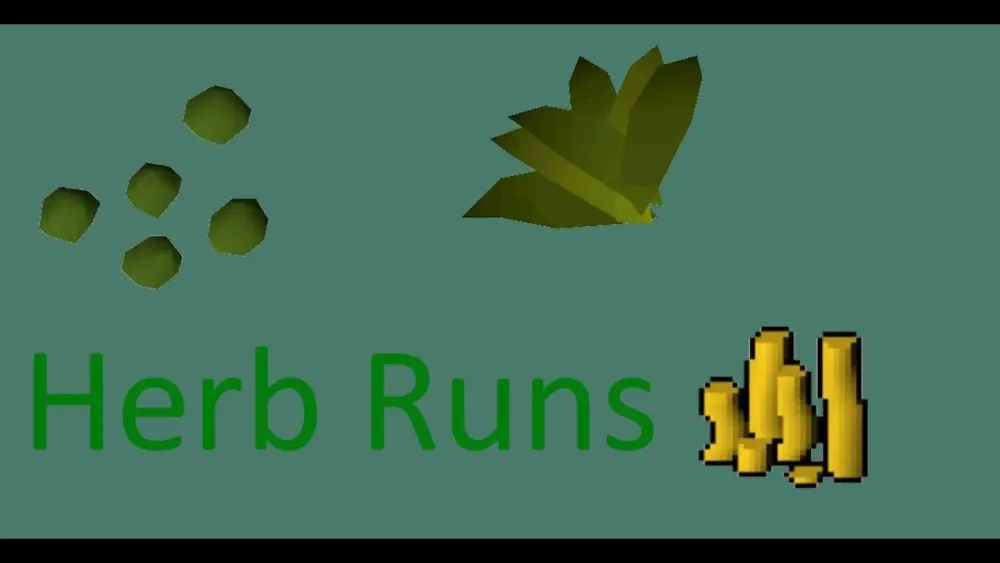Your cart is empty
Ultimate Guide to OSRS Herb Run Route 3: Tips and Tricks

Old School RuneScape (OSRS) offers players a variety of activities to enhance their gameplay experience, and herb runs are among the most efficient methods for training Herblore and generating income. This guide focuses on Herb Run Route 3, providing essential tips and tricks to maximize your herb farming efficiency. Whether you’re a seasoned player or new to the game, mastering herb runs can significantly boost your resources and improve your overall gameplay.
Herb Run Route 3 is a well-structured path designed for players looking to optimize their herb farming in OSRS. This route primarily includes four key locations: the Troll Stronghold, the Hosidius House, the Ardougne, and the Tree Gnome Stronghold. Each location offers unique advantages, allowing players to collect a variety of herbs while minimizing travel time.
To begin the route, start at the Troll Stronghold. Here, you’ll find a patch that grows herbs like Guam and Harralander. It’s advisable to bring a spade and a watering can to ensure your herbs grow successfully. After tending to the patch, use a teleport method, such as the Trollheim Teleport, to reach your next destination quickly.
The next stop is the Hosidius House, which is known for its efficient herb patches. Players with level 50 Farming can access a special feature that allows them to pay to automatically water the plants, saving time and effort. Make sure to plant herbs that are appropriate for your Farming level, as this will yield the best results.
From Hosidius, head to the Ardougne herb patch. This location offers quick access via the Ardougne Cloak teleport. Players can also use the Fairy Ring system (code BJS) for faster travel. The Ardougne patch is ideal for growing herbs like Ranarr, which are highly sought after for potions. Always check for weeds and pests to maintain the health of your crops.
Finally, conclude the route at the Tree Gnome Stronghold. This patch is particularly beneficial for players who have completed the “The Grand Tree” quest, as they can use the nearby gnome glider to travel quickly. The Tree Gnome patch allows players to cultivate a variety of herbs, making it a versatile option.
In summary, to maximize the effectiveness of Herb Run Route 3, ensure you have the necessary supplies, plan your travel methods carefully, and choose the right herbs to plant. With practice, you can significantly enhance your farming efficiency and reap the benefits in OSRS.
3. Required Items for Herb Run Route 3

Before you embark on your herb run adventure in Old School RuneScape (OSRS), it’s crucial to prepare adequately. Having the right items can significantly enhance your efficiency and overall experience. Here’s a list of essential items you’ll need for Herb Run Route 3:
- Seed Dibber: This tool is necessary for planting herbs in the patches.
- Gardening Trowel: Used for digging up dead herbs and maintaining your patches.
- Watering Can: Keeping your herbs hydrated is vital, so don’t forget this!
- Supercompost: This will protect your herbs from diseases and increase yield.
- Teleportation Runes or Items: Consider bringing teleportation methods like Spellbook Teleport or Amulet of Glory to travel quickly between locations.
- Herb Seeds: Of course, you’ll need the herbs you want to plant! Popular choices include Ranarr, Snapdragon, and Torstol.
- Farming Level Requirements: Make sure you have the necessary Farming level to plant your chosen herbs.
- Optional Items: If you have them, consider bringing a Magic Secateurs (for a 10% yield boost) and a Farming Cape (for the ability to check health of patches).
Having these items ready will ensure that your herb run is smooth and productive. Being organized can save you a lot of time and energy!
4. Step-by-Step Guide to Completing the Route
Now that you’re equipped with the necessary items, it’s time to dive into the step-by-step guide for completing Herb Run Route 3. This route typically includes several key locations, so let’s break it down:
- Start at the Farming Guild: Begin your run here. Make sure to check the health of your patches if you have a Farming Cape.
- Teleport to Ardougne: Use your teleportation method to reach Ardougne quickly. If you have completed the Ardougne Diary, you can use the teleport directly to the farming patches.
- Check and Water Your Patches: Head to the herb patches in Ardougne (north of the market) and check for any dead herbs. Water them if necessary.
- Use Supercompost: Apply Supercompost to enhance growth and yield. This step is essential to protect your crops.
- Plant Your Seeds: Use your Seed Dibber to plant your herb seeds in the patches. Make sure you’re planting seeds that you have the level for!
- Teleport to Catherby: After your Ardougne patch is done, teleport to Catherby and make your way to the herb patch located near the bank.
- Repeat Steps 3-5: At the Catherby patch, check, water, and plant again.
- Final Stop at Falador: Use the nearby teleport to Falador and head to the herb patch located just south of the city.
- Complete Your Run: Once all patches are planted, feel free to teleport back to your starting point, or bank your herbs if you need to!
And voilà! You’ve completed Herb Run Route 3. With practice, this route will become second nature, and you’ll find yourself harvesting herbs efficiently in no time!
5. Optimal Timing for Herb Runs
Timing is everything in Old School RuneScape, especially when it comes to herb runs. To maximize your efficiency, you need to consider both in-game time and real-world time. Here are some handy tips:
- Game Time: Herb runs can be affected by the number of herb patches you visit and the time it takes to travel between them. The more patches you can harvest in a single run, the better your yield. Aim to run your herbs every 75-90 minutes to ensure the patches are fully grown.
- Real-World Time: Coordinate your runs with your real-life schedule. If you have time to play in short bursts, consider setting timers to remind yourself when to check back on your patches.
- Herb Growth Time: Most herbs take about 70 minutes to grow. Knowing this will help you plan your runs effectively. Set a schedule that allows you to check your patches at least once every hour.
- Farming Level: Higher Farming levels can unlock better herbs, which may influence your timing. As you level up, experiment with different herbs to see what fits best into your schedule.
By optimizing your timing and being consistent, you can significantly increase your herb yield over time. Remember, patience and planning are key!
6. Maximizing Your Herb Yield
When it comes to herb runs, maximizing your yield is crucial for profit and efficiency. Here are some strategies to help you get the most out of each run:
- Use Compost: Always use compost when planting your herbs. Supercompost is particularly effective, as it increases the yield and reduces the chance of disease.
- Watering Cans: Consider carrying a watering can to keep your plants healthy and increase the yield. This becomes especially important for herbs that could wilt before your next run.
- Herb Lore: Understand the growth times and conditions for each herb. Some herbs have better yields than others, so focus on the ones that provide the best return on investment.
- Farming Contracts: Engaging in farming contracts can give you unique rewards and ensure you are planting the most profitable herbs.
Additionally, consider using the Herblore Habitat and other advanced methods to boost your herb yield. By combining these strategies, you’ll see a noticeable improvement in your herb production and profitability!
Common Mistakes to Avoid
When embarking on your herb run journey in Old School RuneScape (OSRS), it’s essential to be mindful of common pitfalls that can hinder your progress. Here are some of the most frequent mistakes players make:
- Neglecting to Use Super Compost: Many players forget to use super compost on their herb patches. This crucial step not only increases the yield but also reduces the chance of disease.
- Missing Out on the Farming Guild: Some herb runners overlook the benefits of the Farming Guild. This location offers multiple patches and a convenient bank nearby, making it a prime spot for efficient herb runs.
- Ignoring Patch Disease: Failing to check for disease can result in a complete loss of your herbs. Always carry a cure (like a plant cure) to address this issue promptly.
- Inconsistent Timing: Many players don’t stick to a routine. Consistency is key in farming, so try to plan your runs around specific intervals to maximize your herb output.
- Not Using Teleports Wisely: Some players overlook the importance of using teleports effectively. Make sure to utilize the various teleport options available to minimize travel time.
Avoiding these mistakes can significantly enhance your herb farming experience, ensuring you get the most out of your hard work.
Tips for Efficient Herb Farming
If you’re looking to optimize your herb runs in OSRS, here are some practical tips to keep in mind:
- Plan Your Route: Before you set out, plan a specific route that includes all your herb patches. A well-thought-out route can save time and effort.
- Use the Right Gear: Equip gear that boosts your farming efficiency, such as the Farmer‘s outfit, which provides a bonus for farming experience.
- Utilize Herbs for Profit: Consider which herbs are in demand on the Grand Exchange. Growing popular herbs can boost your profits significantly.
- Keep Track of Your Supplies: Always monitor your seed supply and compost. Running low can halt your farming runs, so maintain a healthy stock.
- Join a Farming Community: Engage with other players in forums or in-game. Sharing experiences and tips can lead to new ideas and strategies.
By implementing these tips, you can make your herb farming experience in OSRS not only efficient but also rewarding. Happy farming!
Ultimate Guide to OSRS Herb Run Route 3: Tips and Tricks
The Herb Run Route 3 in Old School RuneScape (OSRS) is an efficient way to gather herbs, providing both experience and profit. This guide will cover the best practices, optimal routes, and essential tips to maximize your herb gathering efficiency.
*Route Overview:
- Start at the Taverley herb patch.
- Travel to Falador herb patch.
- Visit the Catherby herb patch.
- Finish at the Ardougne herb patch.
Essential Tips:
- Ensure you have level 38 Farming to plant and harvest herbs effectively.
- Equip the Magic Secateurs to increase your herb yield by 10%.
- Utilize super compost for the patches to boost your farming success rate.
- Always keep an eye on the Herb Sack to store your harvested herbs efficiently.
- Consider using the Teleportation spells or items to move quickly between patches.
Recommended Herbs*:
| Herb | Experience | Market Price |
|---|---|---|
| Ranarr Weed | 140 | 1,000 GP |
| Snapdragon | 150 | 2,000 GP |
| Torstol | 200 | 5,000 GP |
By following this guide, you can significantly enhance your efficiency when utilizing Herb Run Route 3, leading to greater rewards in both experience and profit.
Conclusion: Mastering Herb Run Route 3 requires strategic planning and efficient execution, but with the right approach and tools, you can optimize your herb runs for maximum rewards in OSRS.
